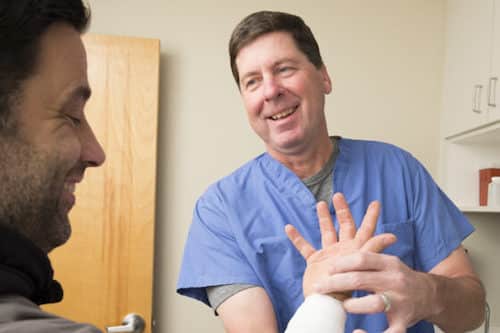The carpal tunnel is a narrow, rigid passageway of ligament and bones at the base of the hand that houses the median nerve and the tendons that bend the fingers. The median nerve provides feeling to the palm side of the thumb and to the index, middle, and part of the ring fingers, but not the little (pinky) finger. It also controls some small muscles at the base of the thumb. Carpal tunnel syndrome (CTS) occurs when the median nerve, which runs from the forearm into the palm of the hand, becomes pressed or squeezed at the wrist. The nerve becomes compressed as a result of thickening from the lining of irritated tendons or other swellings that narrows the tunnel. This compression can cause numbness, weakness, or pain in the hand and wrist, or in the forearm and arm.
CTS is a very common entrapment neuropathy, in which one of the body’s peripheral nerves is pressed upon. It is often the result of repetitive motions, like typing or any motions of the wrist you do over and over again where your hands are typically lower than your wrist.
CTS usually occurs in the dominant hand first and produces the most severe pain.

Who Is At Risk of Developing Carpal Tunnel Syndrome?
Women are three times more likely to develop CTS than men, perhaps because the carpal tunnel is smaller in women than in men.
Also, people who have certain metabolic disorders, such as diabetes, are more susceptible to developing CTS, because these disorders directly affect the body’s nerves and therefore make them more susceptible to nerve compression.
Other medical conditions that may bring on the condition include obesity, hypothyroidism, rheumatoid arthritis, pregnancy, and trauma. When the condition is brought on by pregnancy, the symptoms usually clear up within a few months after delivery.
Additionally, certain jobs that involve repetitive motion with your arm over an extended period of time may increase your chances of getting the condition. Those jobs include:
- Assembly line worker
- Manufacturing
- Meat, poultry, or fish cleaning and packing
- Sewer or knitter
- Baker
- Cashier
- Hairstylist
- Musician
In fact, CTS is three times more common among assemblers than among data-entry personnel.
What Are The Symptoms of Carpal Tunnel Syndrome?
The symptoms associated with CTS usually include a burning, tingling, itching or numbness sensation in the palm of the hand and thumb or index and middle fingers.
At night time you may feel like your fingers are falling asleep and becoming numb. This happens because you are most relaxed during sleep. When you wake up in the morning, the tingling and numbness sensations in your hand may travel up your forearm to your shoulder.
With CTS, symptoms at first may come and go, but over time they tend to occur more often and become worse. Some people may start to feel like their fingers are swollen when they aren’t or they may have intermittent “shocks” in their thumb and fingers.
Over time, CTS can also affect your grip and ability to pinch causing you to
- Drop things more often due to numbness or weakened muscles.
- Have a hard time working with small objects, like the buttons on your shirt.
- Have difficulty making a fist.
In severe cases, you may be losing muscle at the base of your thumb or finding it difficult to tell hot from cold by touch.
What Happens in Severe Cases?
In severe cases of CTS, you may have less grip strength because the muscles in your hand shrink. Pain and muscle cramping may also become worse, and the median nerve begins to lose function due to irritation or pressure around it. As a result, this may lead to:
- Slower nerve impulses
- Loss of feeling in the fingers
- A loss of strength and coordination
- A loss of ability to use your thumb to pinch
What Causes Carpal Tunnel Syndrome?
CTS is a problem due to compression rather than a problem with the nerve itself. There is a combination of factors that reduce the available space for the median nerve within the carpal tunnel that leads to this compression.
When there is pressure on the median nerve, it causes the carpal tunnel to narrow due to swelling. This swelling in your wrist squeezes the tunnel and pinches your median nerve, which causes your symptoms.
There are many factors that contribute to this condition, such as trauma or injury to the wrist that cause swelling, such as a sprain or a fracture, an overactive pituitary gland, an underactive thyroid gland, and rheumatoid arthritis.
Other contributing factors may include mechanical problems in the wrist joint, work stress, repeated use of vibrating hand tools, fluid retention during pregnancy or menopause, or the development of a cyst or tumor in the canal.
When Should You Call a Doctor?
You should see a doctor anytime you have any of the common symptoms of CTS on a regular basis. When you get care early on, you may find that basic options, such as rest or wearing a wrist brace, work well. That’ll allow you to avoid more serious treatment like surgery. Without any treatment, your symptoms could become permanent.
How Is Carpal Tunnel Syndrome Diagnosed?
CTS is easier to treat when your doctor diagnoses it early. Don’t hesitate to go to the doctor if you have symptoms. Early treatment can lead to a shorter recovery time.
During your consultation, your doctor will
- Start with questions about your medical history or physical activity to determine if your pain is due to another condition, like an injury or arthritis, or a new exercise regimen.
- Perform a physical exam of your hands, arms, shoulders, and neck.
- Examine your wrist to see if the area is tender, swollen, warm, or discolored.
- Test each finger to see if you’ve lost any feeling.
- Check the strength of the muscles in your hand.
Your doctor may also do or order tests that focus on the median nerve. These tests may include
Tinel’s Sign. The doctor taps or presses on the median nerve in your wrist with a reflex hammer. If your fingers tingle or if you feel an electric-shock-like sensation, the test is positive for CTS.
Phalen’s Maneuver. This is also known as the wrist-flexion test. The doctor tells you to press the backs of your hands and fingers together with your wrists flexed and your fingers pointed down for 1-2 minutes. If your fingers tingle or get numb, you have carpal tunnel syndrome.
Two-Point Discrimination Test. The doctor uses a gadget called a 2-point disk-criminator, a small, flat, eight-sided tool with needle-like prongs sticking out from all sides. It tests to see if you can tell if two objects touching your skin are two distinct points instead of just one and the distance at which you can feel only one point will help to figure out nerve function and compression (two important components of CTS).
Nerve Conduction Velocity Test. The doctor places a small electrode on your skin near your elbow. It sends a mild electrical current down your median nerve. The more time it takes for the current to travel from your elbow to your fingers, the more damage to your median nerve.
Electromyogram. The doctor places a small needle electrode into muscles in your hand and arm that get impulses from the median nerve. This nerve conduction study measures how well the muscle around your median nerve works and tells the doctor if your median nerve is damaged or being squeezed.
Ultrasound, X-ray, and MRI. The doctor may order one of these tests to rule out other causes of wrist and hand pain. An X-ray can show arthritis or a broken bone. An ultrasound or MRI will show a swollen or compressed median nerve.
Routine Laboratory Tests. The doctor may order blood work to look for diseases like diabetes that can damage your nerves.
How Is Carpal Tunnel Syndrome Treated?
There are many treatment options available for CTS that include both non-surgical and surgical approaches. Since it is a condition that comes on slowly and gets worse over time, it is best to treat it early for the best outcome.
Non-Surgical Treatments
These treatments don’t cure CTS, but they may give you short-term relief.
Self-Care. There are several self-care things you can do to ease the symptoms of CTS including:
- Put ice on your wrist or soak it in an ice bath for 10-15 minutes, once or twice an hour.
- Shake your wrist or hang it over the side of your bed for pain that wakes you up at night.
- Put your hand in warm water, around 100 degrees Fahrenheit, and gently flex and extend your hand and wrist. Do this 3-4 times a day.
Splinting. Wrist braces are recommended for patients with mild to moderate CTS. Patients wear them all day and night (except when showering) for 3-4 weeks for symptoms to improve. Wrist braces help to keep the wrist immobile and lessen pressure on the nerve.
Tweak Your Activities. To alleviate the symptoms associated with CTS, you may want to avoid doing daytime activities that may provoke symptoms or tweak your activities. Overall, it is best to keep your wrist in a straight, neutral position as much as possible.
Of course, being at work doesn’t always allow you to do this, so try some of these tips to help alleviate symptoms during the work day:
- Take a break for 10-15 minutes every hour and stretch your hands.
- Talk to your manager to see if you can change your desk, tools, or workstation setup.
- Try to alternate which hand you use for your tasks.
- Use only as much force as you need. Don’t hold your tools too tightly or pound away at your keyboard.
- Watch your posture. Try not to roll your shoulders forward, which sets off a chain reaction that makes wrist problems even worse.
Over-The-Counter Drugs. To ease the pain and swelling, take over-the-counter meds like aspirin, ibuprofen, or naproxen.
Prescription Medicines. Corticosteroids, such as prednisone, are taken by mouth to relieve pressure on the median nerve, and Lidocaine can be injected directly into the wrist. These drugs can offer temporary relief of pain and swelling, but they are not a long-term solution.
Note: Corticosteroid medicines are not recommended for people with diabetes or those predisposed to diabetes, as prolonged use of corticosteroids can make it difficult to regulate insulin levels.
Physical and Occupational Therapy. Physical and occupational therapists may give you exercises to stretch and strengthen your hand and wrist muscles. They can also show you how to modify your routine motions in a way that eases stress on your hands and wrists. This is especially helpful for tasks related to work or your favorite hobbies.
Ultrasound therapy. This treatment uses sound waves to raise the temperature in your hand and wrist. The heat can relieve pain and help with healing.
Alternative Therapies. Yoga has been shown to be effective in relieving pain and improving grip strength. Some people have tried acupuncture and chiropractic care, but the effectiveness of these two therapies remains questionable.
Surgical Options
If after 6 months your symptoms haven’t improved, your doctor may suggest carpal tunnel release surgery.
Carpal tunnel release surgery involves severing a ligament around the wrist to reduce pressure on the median nerve. It can be done as an outpatient procedure under local or regional anesthesia (involving some sedation).
There are two different methods that can be performed to correct CTS including:
- Open Release Surgery. This is the traditional method in which the surgeon makes an incision up to 2 inches in the wrist and then cutting the carpal ligament to enlarge the carpal tunnel.
- Endoscopic Surgery. In this procedure, the surgeon uses an endoscope to see structures in the wrist without opening the entire area with a large incision. The surgeon makes one or two incisions (about ½ inch each) in the wrist and palm, inserts the camera attached to a tube, observes the nerve, ligament, and tendons on a monitor, and cuts the carpal ligament with a small knife that is inserted through the tube. This procedure allows for faster recovery and less post-operative discomfort than the traditional open release surgery.
After either surgery, ligaments usually grow back together and allow more space for the nerve to pass through. Even though surgery may relieve symptoms immediately, full recovery from carpal tunnel surgery can take months. Since it is not uncommon for patients to experience some residual numbness or weakness after surgery, patients may need to modify their work schedule for several weeks following surgery.
What Happens If You Don’t Get Treatment?
If you don’t get treatment for CTS, you could end up with permanent muscle damage and lose function in your hand. Symptoms can last a long time, get worse, and can even go away and return. Don’t put off seeing a doctor.
How Can Carpal Tunnel Syndrome Be Prevented?
There are several things you can do at home and at work to prevent CTS:
At Home
- Keep your wrists straight.
- Use a splint or brace that helps keep your wrist in a neutral position.
- Avoid flexing and extending your wrists repeatedly.
- Talk to your doctor about exercises that may help.
- Correctly position your hands and wrists while working.
- Arrange your activity and workspace in a way that minimizes any discomfort.
At Work
- Perform stretching exercises
- Take frequent rest breaks
- Ensure correct posture and wrist position at workstations
- Wear fingerless gloves to keep hands warm and flexible
- Request that jobs be rotated among workers
- Suggest that tasks be modified (if possible) to enable the worker’s wrist to maintain a natural position during work
- Ask employers to develop programs in ergonomics (adapting workplace conditions and job demands to the capabilities of workers)
Come See Us
At Go To Ortho, we provide quick-care orthopedic injury treatment for cost-effective care at medical office rates, not hospital rates.
Sources
National Institute of Neurological Disorders
Walk-in appointments are welcome. View our hours.



